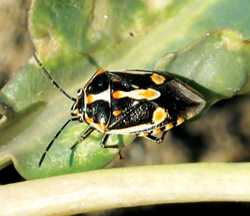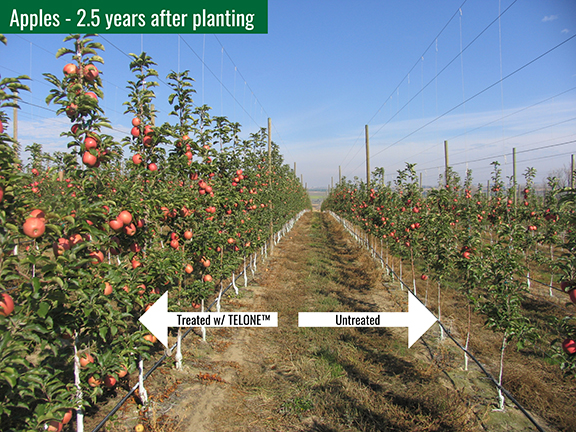A Barrage Of Bugs

Insect pests are a challenge for growers every year. To help you in your fight against bugs, we asked several researchers from across the country to offer some insight on the latest pest issues and what growers will need to be aware of for the coming season.
New Pest In The West
In the West, John Palumbo, professor and Extension specialist for vegetable crops entomology at the University of Arizona, says growers need to be aware of a new invasive pest attacking cole crops, the bagrada bug.
“In Sept. 2009, consultants reported finding small black stink bugs with orange markings that resembled harlequin bugs damaging seedling and newly transplanted cole crops,” Palumbo explains. “By October, reports of the bug and damaged crops were widespread throughout Yuma, AZ, and the Imperial, Coachella, and Palo Verde Valleys of California. It was first found in the U.S. in Orange County, CA, in 2008, and is thought to be indigenous either to Africa or India.”
Palumbo says the bagrada bugs damaged broccoflower, broccoli, cabbage, cauliflower, Chinese cabbage, kale, radish, rutabaga, collards, arugula, turnip, and mustard. In addition to Brassica plant species, he says bagrada bugs have been reported to attack potato, maize, sorghum, cotton, some legumes, and mustard weed species.
Adults are feeding on cotyledons, newly emerged leaves, and the apical meristems. “Heavy feeding caused leaves on small plants to wilt and desiccate,” he explains. “In addition, feeding on the terminal growing point often caused a loss of apical dominance, resulting in spindly plants with multiple head development.”
To combat this pest, Palumbo tells growers to apply control measures on seedling plants when 5% of the plants become infested. “Efficacy trials conducted locally have shown that contact insecticides such as the pyrethroids, Lannate (methomyl, DuPont Crop Protection) and Lorsban (chlorpyrifos, Dow AgroSciences) can effectively prevent feeding damage on cole crops. Foliar applied neonicotinoids, Assail (acetamprid, United Phosphorus, Inc.), Venom (dinotefuran, Valent U.S.A. Corp.), and Belay (clothianidin, Valent U.S.A. Corp.) were also effective.”
More Stink Bug Problems
Stink bugs are particularly difficult to control because sampling is difficult in vegetable crops, says Kuhar. “Adults are highly mobile and move into and out of crops as fruiting stages appear,” he says.
To control stink bugs, Kuhar suggests pyrethroid insecticides, or neonicotinoids such as Actara (thiamethoxam, Syngenta Crop Protection), Assail, Provado (imidacloprid, Bayer CropScience), or Venom. Additionally, a few newer products combine both a pyrethroid and neonicotinoid.
He adds that insecticidal control efficacy varies with pest species. “The red banded and brown stink bugs can be harder to control than other species.”
Insects Vectoring Disease
Thrips are also joining the ranks of insects that appear to be an increasing problem for growers. In the coastal California region, tospovirus problems, such as tomato spotted wilt virus (TSWV), and impatiens necrotic spot virus (INSV), which are transmitted by various species of thrips, have been escalating over the past few years. Growers should expect more of the same in 2010, says Steven Koike, plant pathology farm advisor, Monterey County, University of California Cooperative Extension.
Lettuce, pepper, and tomato typically have been the crops affected by thrips, but Koike says he is now finding that a number of minor vegetable crops are also becoming infected including radicchio, fava bean, basil, and spinach. Disease symptoms for tospoviruses, he says, include discoloration and malformation of foilage, stunting of the plant, and pepper fruit with ringspots and blotches.
These viruses are hard to manage and prevent, says Koike. He encourages growers to use labeled materials to spray for thrips, although this will not prevent the transmission of the virus. He also says growers should plant crops in areas that do not have a history of severe disease.
He cites iris yellow spot virus on onions, a disease that is also vectored by thrips, as an example. “This disease has shown up in a lot of areas and it has been devastating,” he says. “Georgia has not been as impacted as some growers in other areas of the country. The reason why it isn’t as bad here as in other areas of the country is because Georgia grows onions during the cool part of the year when thrips populations are lower.”
Further south, Gene McAvoy, county Extension director/regional vegetable agent IV at the University of Florida, Institute of Food and Agricultural Sciences, Hendry County Extension, says whiteflies are a perennial issue, especially on tomatoes and cucuribts, vectoring viral diseases such as tomato yellow leaf curl virus.
Signs of a whitefly infestation, he says, are the presence of nymphs and adults, virus on tomatoes and melons, sooty mold, silvering of foliage, and irregular ripening of tomatoes. McAvoy says scouting is essential with this pest. Growers must practice IPM including sanitation, crop destruction after harvest, and crop-free periods.
To control whiteflies, McAvoy suggests using nicotinoids such as Admire (imidacloprid, Bayer CropScience), Platinum (thiamethoxam, Syngenta Crop Protection), and Venom; anti-feedants like Fulfill (pymetrozine, Syngenta Crop Protection); insect growth regulators such as Courier (buprofezin, Nichino America, Inc.) and Knack (pyriproxyfen, Valent U.S.A. Corp.); as well as Thiodan (thiodanendosulfan, Universal Crop Protection Alliance LLC).
Disease Update
Insects vectoring disease is always a concern for growers as is the destructive disease downy mildew. According to UC’s Koike, downy mildew is always an issue in California’s cool, humid coastal region. Making the situation even more challenging for growers, the region’s spinach crop is being affected by several new races of downy mildew which overcome the resistance genes in newer cultivars, he adds.
Symptoms include bright yellow leaf spots, with purple sporulation of the fungus on leaf underside. What can growers do? Koike advises them to plant resistant cultivars. He says resistant cultivars will hold up to many of the races, but they may not hold up to the new ones. He also tells growers to use fungicides and to spray early with multiple applications.
In addition, Koike says Verticillium wilt of lettuce, first described in 1995, continues to be a concern in California. Being soilborne, it has slowly spread to additional fields. “This is important because, as a long term soil inhabitant, once the pathogen is in a field, it will likely remain there for many years,” he explains.
Some symptoms, he says, occur near crop maturity. The lettuce will begin to show problems of lower leaf yellowing, lower leaf collapse and death, and eventually collapse and death of the entire plant.
To combat this problem, Koike tells growers to keep good production records and do not plant in infested fields. “Fumigation is possible, but it may not be an economical option for lettuce production,” he explains. “Rotate ground with strawberry growers, who tend to fumigate prior to strawberry production and hence have ‘clean’ ground for subsequent vegetable crops. However, remember that fumigation is not perfect, so pathogens can remain in the soil. Also, the strawberry and lettuce isolates of V. dahliae do cross infect.”










